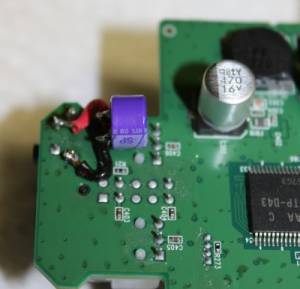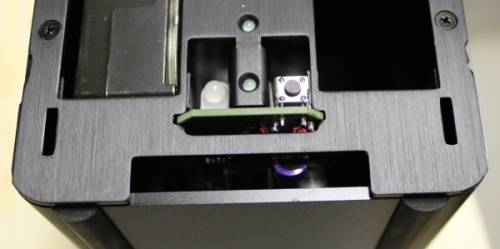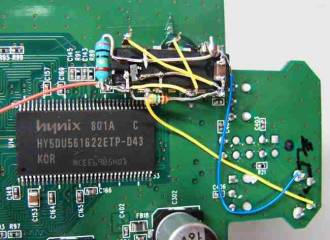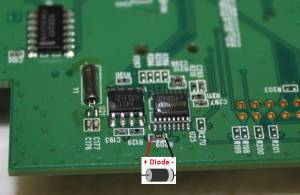This is an old revision of the document!
DNS-323 Automatic Power On
As a manufacturer of embedded computers we have a special appreciation of the DNS-323 – it's a beautiful little embedded network server. We're using it as a backup server where it's important that it resumes its duties after a power failure. So we needed a circuit to automatically turn it on a short while after AC line voltage is restored after a power down from a UPS-signaled power failure or other power failure. It seems to work well, so we thought others might find it useful.
Here's a circuit using a NE556N dual timer IC that automatically turns the DNS-323 on whenever power is first applied or re-applied after power failure. This circuit is applicable to the DNS-323 hardware version B1: 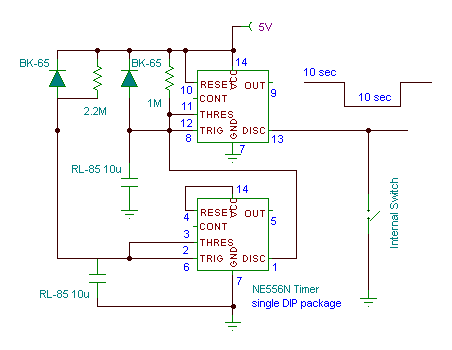
For older DNS-323 hardware versions
The above circuit works for hardware version B1, which has a power switch that grounds an input line. Older versions of the DNS-323 hardware may have a power switch that pulls a line up on closure instead. Skydreamer provided a revision of the above circuit for the older hardware versions.
Skydreamer's note for older hardware revisions: This auto power on circuit needs to be modified for older hardware revisions that drive the switch from +12V instead of 0V. You will need one resistor 47 kOhm and one PNP signal transistor (such as BC560). Connect NE556 pin#9 over the 47 kOhm resistor (anywhere from 10K to 50K should work fine) to the base of the PNP transistor. The emitter is connected to the side of the switch marked with the black grounding symbol (not the grounding shield!), the collector to the opposite one with the yellow wire attached on the picture. Do not connect pin#13 to the switch- leave out the yellow wire. Power the circuit from +12V and not +5V as advised below. That is, modify the above circuit to take power from 12V and to feed its pin 9 output to a PNP transistor placed directly across the DNS-323 switch, as shown in the following schematic: 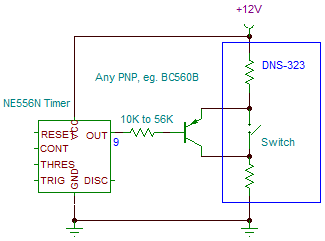
Circuit operation
After power up, the timer waits ten seconds, simulates a switch closure for another ten seconds, then removes itself from the circuit. If the power flickers when it returns, the circuit just resets itself so that it initiates the switch closure only after ten full seconds of clean, uninterrupted power.
The circuit comprises two timers. For each, the trigger input is active low and triggers at ⅓ Vcc, setting the outputs (the open-collector discharge output and the standard output) high; the threshold input is active high and triggers at ⅔ Vcc, setting the outputs low. On power-up, both timers outputs are high. After ten seconds the top timer's capacitor charges to the threshold and its output goes low. Twenty seconds after power-up the bottom timer's capacitor charges to the threshold and its output goes low, pulling the trigger on the first timer low, resetting the first timer's output high. The discharge outputs are used as they are open-collector outputs. The top timer's discharge output should be wired across the DNS-323's front panel power switch. That switch is pulled up internally to 5V, which this circuit momentarily switches to ground. Power is taken from the 5V on the incoming power connector.
Parts List
You can vary component values over a wide range, so long as the RC product of the bottom timer is about twice that of the top timer. I used RCtop = 10 seconds and RCbottom = 20 seconds, but you can use anything down to about a second. Component values are not critical!
- The NE556N (14-pin DIP) is available from Digikey for $0.48.
- The 1MΩ and 2.2MΩ resistors can be of any type. You can change their values over a wide range, so long as the larger one is about twice the value of the smaller.
- Any standard silicon diodes may be used, but stay away from Schottky diodes as they often have large leakage currents.
- The 10μF capacitors should not have high leakage, most any will do. I used small ceramic capacitors.
Construction and installation
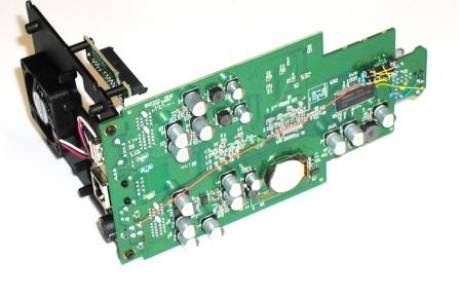 I soldered the passive components onto the pins of the NE556, which was a 14-pin DIP package. The package was then hot-glued onto the underside of the DNS-323 board near the power switch and the output of the timer circuit was wired across the front panel power switch. (With a DVM you'll see that one side of the power switch is grounded to the DNS-323 board's ground plane while the other floats to 5V when the switch is not pressed.)
I soldered the passive components onto the pins of the NE556, which was a 14-pin DIP package. The package was then hot-glued onto the underside of the DNS-323 board near the power switch and the output of the timer circuit was wired across the front panel power switch. (With a DVM you'll see that one side of the power switch is grounded to the DNS-323 board's ground plane while the other floats to 5V when the switch is not pressed.)
 Connect the circuit ground to the DNS-323 ground near the front panel switch, connect the output across the front panel switch, and take power from DNS-323 board at the +5 V back panel connector. Use the +5V power pin rather than the +12V pin for power.
Connect the circuit ground to the DNS-323 ground near the front panel switch, connect the output across the front panel switch, and take power from DNS-323 board at the +5 V back panel connector. Use the +5V power pin rather than the +12V pin for power.
The red wire connects the timer circuit to the +5V pin of the power plug at the back edge of the DNS-323 board, the blue connects to ground at the power switch, and the yellow connects to the active side of the power switch.
If you are successful, whenever the power is plugged in the DNS-323 should automatically turn on after about ten seconds.
Other solutions
There is also another auto turn on circuit available, this one using a hex inverter.
Single capacitor solution (B1 hardware)
Background info: The power on button is connected to pin 1 of HT48R05A-1 (U25) and has a weak 120k pull up. The H48R05A-1 is an 8 bit micro-controller from Holtek which conveniently handles very slow rise time inputs.
Solution: With such a weak pull up value, all you need is a (fairly large) capacitor to delay the rise time, which tricks the HT48R05A-1 in thinking the power button has just been released.
How to do the mod
- Disassemble your DNS-323 (4 screws on the front, 4 screws in the back, another set of 4 screws in the back, and you're done).
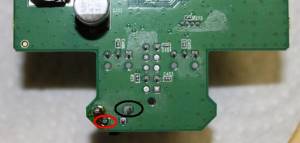 Solder a 150uF (6.3V or higher) electrolytic capacitor between the ground (circled in black) and the power on pin (circled in red).
Solder a 150uF (6.3V or higher) electrolytic capacitor between the ground (circled in black) and the power on pin (circled in red). - NOTE: electrolytic capacitors are polarized!!!
- Make sure the negative is soldered to ground (the side of the capacitor will have a large stripe next to the pin).
- About the capacitor… I am pretty sure a lower value (ex.: 68uF) will also work, but I didn't try. I have a feeling high ESR capacitors are better since a 15uF unpolarized capacitor (used for AC relays) worked fine yet it's 15 uF electrolytic equivalent didn't.
- Reassemble your DNS-323 and enjoy.
Note: The power switch still works to power off the unit, and to power it back on if it was powered down by the switch or by software shutdown.
Limitations
- Doesn't work for power glitches (anything below 3-4 seconds).
- If you are serious about your NAS, it should be on a UPS (which filter glitches) and therefore you don't need to add a diode…
Assembly pictures
I stole an electrolytic capacitor from a unused electronic circuit. The leads weren't long enough, so I had to use wire. The electrolytic capacitor you'll buy will likely have leads long enough so you won't need to go through this hassle. (But make sure that non-isolated leads don't touch front panel after assembly. The panel is actually made of (anodized) aluminum and there can easily be a short-circuit, leading to router powering down soon after start up - or worse.)
